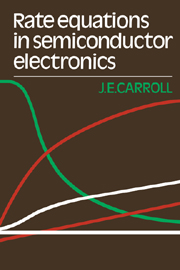Book contents
- Frontmatter
- Contents
- Preface
- 1 Introduction to rate equations
- 2 Elementary rate equations in semiconductors
- 3 Rates of switching
- 4 Rates of change and transfer in phase space
- 5 Rate equations in quantum electronics
- 6 Rate equations in optoelectronic devices
- 7 Advanced topics in rate equations
- Appendix A Counting states
- Appendix B Notes on differences between gas and diode laser rate equations
- Notes on solutions
- References
- Index
Preface
Published online by Cambridge University Press: 04 December 2009
- Frontmatter
- Contents
- Preface
- 1 Introduction to rate equations
- 2 Elementary rate equations in semiconductors
- 3 Rates of switching
- 4 Rates of change and transfer in phase space
- 5 Rate equations in quantum electronics
- 6 Rate equations in optoelectronic devices
- 7 Advanced topics in rate equations
- Appendix A Counting states
- Appendix B Notes on differences between gas and diode laser rate equations
- Notes on solutions
- References
- Index
Summary
Collecting fresh fruits becomes ever harder as the tree of knowledge grows higher and wider. However, there are certain branches that provide surer footholds to the new growths, and teachers must search these out. The rates of change of charge, energy, momentum, photon numbers, electron densities and so on, along with their detailed balances as particles and systems interact, provide fundamental footholds on sturdy branches in physics and chemistry. This book contains a collection of such topics applied to semiconductors and optoelectronics in the belief that such analyses provide valuable tutorial routes to understanding past, present and future devices. By concentrating on rates of change one focuses attention on these devices' dynamic behaviour which is vital to the ever faster flow of digits and information. The rates of the statistical interactions between electrons and photons determine distributions of energy amongst the particles as well as determining distributions in time, so controlling the ways in which devices work.
The first chapter is meant to be a fun chapter outlining some of the breadth and ideas of rate equation approaches. It is even hoped that some of these initial ideas may be picked up by sixth form teachers. Rates of reactions are mentioned in school chemistry but the implications are much broader.
Most electronic degree courses consider electron waves, holes and electrons, along with devices such as p-n junctions, FETS and bipolar transistors. Chapters 2 and 3 are adjuncts to this work. By considering rates of change of charge and emphasising transit times and recombination rates the dynamics of these devices can be highlighted.
- Type
- Chapter
- Information
- Rate Equations in Semiconductor Electronics , pp. xi - xiiPublisher: Cambridge University PressPrint publication year: 1986

